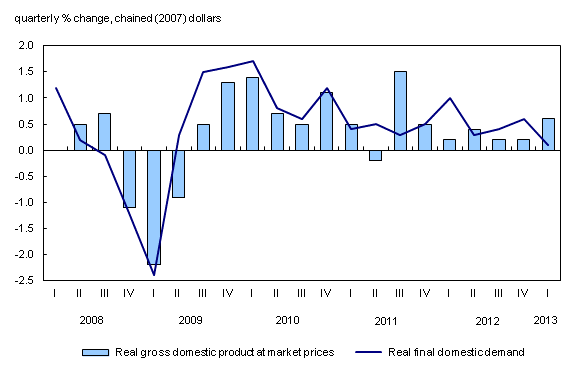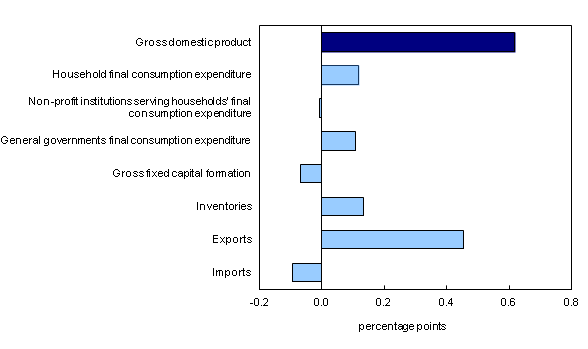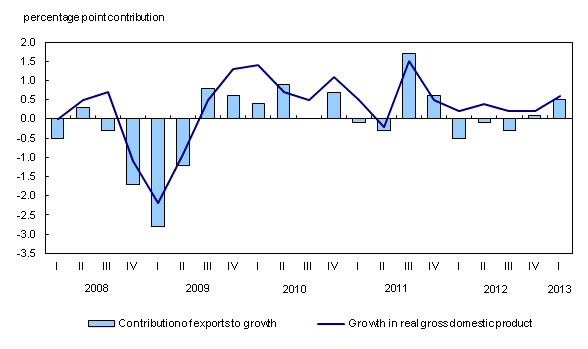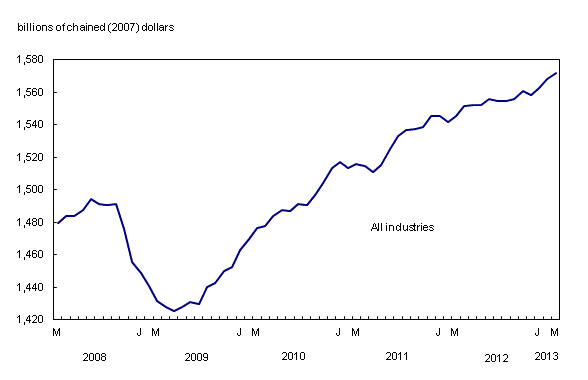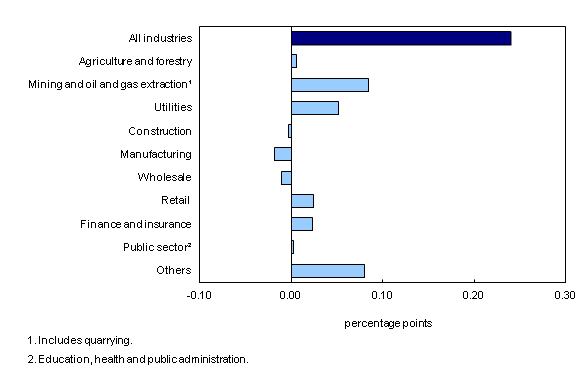Canadian economic accounts, first quarter 2013 and March 2013
Archived Content
Information identified as archived is provided for reference, research or recordkeeping purposes. It is not subject to the Government of Canada Web Standards and has not been altered or updated since it was archived. Please "contact us" to request a format other than those available.
Released: 2013-05-31
Real gross domestic product (GDP) expanded 0.6% in the first quarter, the fastest pace in six quarters, bolstered by a 1.5% increase in exports. On a monthly basis, real GDP by industry grew 0.2% in March.
Exports were the largest contributor to growth in the quarter. Export volumes increased 1.5%, after a gain of 0.2% in the fourth quarter of 2012 and declines in the previous three quarters. Imports were up slightly by 0.3%, after falling 0.8% in the previous quarter.
Final domestic demand edged up 0.1%, the weakest showing since the first quarter of 2009.
Consumer spending was up 0.2%, sustained by higher spending on services.
Investment declined as business investment in residential structures fell 1.2%. New home construction declined and housing resale activity showed continued weakness. Business investment in plant and equipment was up 0.2%, following a 1.3% increase in the previous quarter.
Government final consumption expenditures increased 0.5%, in line with the previous quarter.
Businesses added $5.9 billion worth of goods to inventories, after adding $3.9 billion in the previous quarter.
Mining and oil and gas extraction (+4.1%) was the main source of industrial growth in the first quarter, as was the case in the fourth quarter of 2012. Increases were also recorded in the public sector, the finance and insurance sector, the arts and entertainment sector, construction, and retail trade. Following two quarterly declines, manufacturing (+0.1%) also increased, as gains in non-durable goods manufacturing outweighed the declines in durable goods production. Transportation and warehousing, professional services and administrative services declined.
Expressed at an annualized rate, real GDP expanded 2.5% in the first quarter. By comparison, real GDP in the United States grew 2.4%.
Exports increase
Exports of goods and services rose 1.5% in the first quarter, after four weak quarters in 2012.
Exports of goods grew 1.8%, following a 0.5% increase in the previous quarter. Energy products (+5.1%), metal and non-metallic mineral products (+5.9%) and consumer goods (+4.6%) were among the major contributors to the increase.
Exports of motor vehicles and parts fell 7.5%, a second consecutive quarterly decline. Exports of aircraft and other transportation equipment and parts, and farm, fishing and intermediate food products were also lower.
Service exports increased 0.2%, after a 1.5% decline in the previous quarter. The increase was driven by higher exports of transportation (+1.2%) and travel (+0.6%) services. Commercial services exports (-0.1%) decreased for a second consecutive quarter.
Imports higher
Imports of goods and services rose 0.3% in the first quarter. Imports have increased in all but one quarter since the second quarter of 2009. The exception was the fourth quarter of 2012 (-0.8%).
Imports of goods advanced 0.7%. Most major categories of goods imports were up, with metal ores and non-metallic minerals (+21.3%), basic and industrial chemicals, plastic and rubber products (+1.9%) and consumer goods (+1.0%) contributing most to the increase. Imports of industrial machinery, equipment and parts, one of the driving factors behind the growth of imports since the first half of 2009, were up 1.3% for the quarter.
Imports of energy products fell 4.3%, after three consecutive quarters of growth. Imports of metal and non-metallic mineral products (-3.2%) were lower for a second consecutive quarter.
Service imports decreased 1.6%, the second consecutive decline. Commercial services (-2.6%) and travel services (-1.8%) were the main sources of weakness.
Business investment in plant and equipment edges up
Business investment in plant and equipment increased slightly by 0.2% in the first quarter, following a 1.3% gain in the previous quarter. Business investment in non-residential structures increased 0.4%, the second consecutive quarterly gain.
Business investment in machinery and equipment fell 0.2%, the first quarterly decrease since the third quarter of 2011. Industrial machinery and equipment (+0.6%) and medium and heavy trucks, buses and other motor vehicles (+1.4%) were the main sources of strength.
Business outlays on computers and computer peripheral equipment (-3.1%) and communications and audio and video equipment (-0.5%) were both lower.
Housing investment weakens
Business investment in residential construction fell 1.2% in the first quarter, the third consecutive quarterly decline.
The value of new home construction fell 2.9%, the first decline since the first quarter of 2011. Renovation activity (+0.6%) increased for the third straight quarter. Ownership transfer costs (-0.5%) were down for a fourth consecutive quarter, indicating continued weakness in housing resale activity.
Inventory accumulation strengthens
Businesses added $5.9 billion worth of goods to inventories in the first quarter, $2.0 billion more than was added in the previous quarter.
Manufacturers, wholesalers and retailers all added to their stocks of durable and non-durable goods. Inventories of motor vehicles at the retail level were up substantially (+$3.6 billion). Other non-farm inventories were lower, following a significant increase in the previous quarter.
Farm inventories declined $1.7 billion, the sixth consecutive quarterly decrease, as holdings of grains, livestock and crops were sold off.
The economy-wide ratio of stock to sales was unchanged from the previous quarter.
Consumer spending continues to rise
Household final consumption expenditure edged up 0.2% in the first quarter, after growing 0.5% in the previous quarter. Outlays on goods were flat in the quarter, while spending on services advanced 0.4%.
Clothing and footwear (+1.3%) and furnishings, household equipment and other goods and services related to the dwelling (+0.8%) were among the main contributors to growth in household spending.
Transport purchases fell slightly by 0.1% as higher outlays on vehicles (+0.4%) were offset by lower spending on vehicle operations (-0.2%) and transport services (-1.0%).
Consumption of electricity, gas and other fuels fell 1.1%, following strong growth in the second half of 2012. Spending on recreation and culture (-0.7%) was also down, following increases in the two previous quarters.
Expenditures by Canadians travelling abroad declined 1.3%.
Economy-wide income grows
Nominal GDP increased 0.9% in the first quarter, the fastest pace in five quarters. This followed a 0.7% increase in the fourth quarter of 2012.
Compensation of employees rose 0.7%, the same as in the previous quarter, but weaker than the three-year average of 1.1%. Wages and salaries in goods-producing industries were up 0.5%, the slowest pace since the third quarter of 2009. Wages and salaries in service-producing industries rose 0.8% in the first quarter.
The net operating surplus of corporations increased 0.5%, following four quarters of decline. Net operating surplus of non-financial corporations grew 0.3%, after decreasing throughout 2012. Financial corporations recorded a 2.9% gain in net operating surplus in the first quarter of 2013, following two quarterly declines.
Household savings up
Household final consumption expenditures (in current dollars) grew 0.6% in the first quarter. Household disposable income advanced 0.7%, after averaging gains of 1.1% in the previous nine quarters. The household saving rate rose to 5.5% from 5.4% in the previous quarter. The rate has trended upward since hitting a low of 0.9% in the first quarter of 2005.
The household debt service ratio (7.24%), defined as household mortgage and non-mortgage interest paid divided by disposable income, remained at a near record low in the first quarter, reflecting continued low interest rates.
The national saving rate rose to 5.2% from 3.9% in the previous quarter. The increase resulted mostly from higher corporate savings. National disposable income increased 2.2%, following a 0.2% increase in the fourth quarter of 2012.
Weaker terms of trade
A deterioration in Canada's terms of trade, resulting from lower prices for exports relative to imports, tempered the growth in real gross domestic income to 0.4% in the first quarter.
Export prices increased 0.6%, while import prices were 1.2% higher. The overall price of goods and services produced in Canada rose 0.4%, following a 0.5% gain in the previous quarter.
The price of final domestic demand rose 0.5%, after 0.2% growth in the fourth quarter of 2012.
Gross domestic product by industry, March 2013
Real gross domestic product grew 0.2% in March, a third consecutive monthly increase. Mining, quarrying, and oil and gas extraction, and utilities were the main sources of growth. Retail trade and the finance and insurance sector also increased. Manufacturing and wholesale trade declined. Construction and the public sector (education, health and public administration combined) were unchanged.
Mining, quarrying and oil and gas extraction grew 1.2% in March, a sixth consecutive monthly increase. Oil and gas extraction increased 1.8% on the strength of crude oil production. Mining excluding oil and gas extraction posted a gain of 2.3%, mainly due to increases in potash and, to a lesser extent, coal mining. In contrast, support activities for mining and oil and gas extraction fell 4.1% as a result of a decline in rigging services.
Utilities expanded 2.1% in March, after increasing 0.9% in February, as the demand for both electricity and natural gas increased.
Retail trade rose 0.5% in March. Increased activity at motor vehicles and parts dealers, and clothing and clothing accessories stores led the increase. On the other hand, wholesale trade declined 0.2%, primarily because of a decrease in the wholesaling of machinery and equipment, and personal and household goods.
The finance and insurance sector grew 0.4% in March. Banking, insurance services and financial investment services all increased.
Manufacturing declined 0.2% in March, after increasing 0.7% in February. A decline in durable goods manufacturing more than offset a slight gain in non-durable goods production. Primary metal manufacturing, printing and related support activities, and electrical equipment manufacturing were the main sources of decline. In contrast, increased production was recorded at refineries and by manufacturers of beverage and tobacco products.
Construction was unchanged, as a decline in residential building construction offset increases in engineering and non-residential building construction. The output of real estate agents and brokers rose in March.
Products, services and contact information
Detailed analysis and tables
The National economic accounts module, accessible from the Browse by key resource module of our website, features an up-to-date portrait of national and provincial economies and their structure.
Links to other releases from the national accounts can be found in the first quarter 2013 issue of Canadian Economic Accounts Quarterly Review, Vol. 12, no. 1 (Catalogue number13-010-X). This publication is now available from the Browse by key resource module of our website under Publications. This publication will be updated on June 20, at the time of the release of the financial flow and national balance sheet accounts.
Note to readers
For more information on seasonal adjustment, see Seasonal adjustment and identifying economic trends.
Percentage changes for expenditure-based and industry-based statistics (such as personal expenditures, investment, exports, imports and output) are calculated from volume measures that are adjusted for price variations. Percentage changes for income-based and flow-of-funds statistics (such as labour income, corporate profits, mortgage borrowing and total funds raised) are calculated from nominal values; that is, they are not adjusted for price variations.
There are four ways of expressing growth rates for gross domestic product (GDP) and other time series found in this release.
1. Unless otherwise stated, the growth rates of all quarterly data in this release represent the percentage change in the series from one quarter to the next, such as from the fourth quarter of 2012 to the first quarter of 2013.
2. Quarterly growth can be expressed at an annual rate by using a compound growth formula, similar to the way in which a monthly interest rate can be expressed at an annual rate. Expressing growth at an annual rate facilitates comparisons with official GDP statistics from the United States. Both the quarterly growth rate and the annualized quarterly growth rate should be interpreted as an indication of the latest trend in GDP.
3. The year-over-year growth rate is the percentage change in GDP from a given quarter in one year to the same quarter one year later, such as from the first quarter of 2012 to the first quarter of 2013.
4. The growth rates of all monthly data in this article represent the percentage change in the series from one month to the next, such as from February to March 2013.
Data on gross domestic product by industry for April will be released on June 28.
Products
Revised data on gross domestic product by income and by expenditure accounts for the first quarter of 1981 to the fourth quarter of 2012 have been released, along with those for the first quarter of 2013. These data incorporate revisions back to 1981 reflecting several methodological and statistical changes under the new comprehensive revision policy of the Canadian System of Macroeconomic Accounts, as well as incorporation of new and revised source data and updated data on seasonal patterns.
Data on gross domestic product by income and by expenditure for the second quarter will be released on August 30. For more information, consult the Guide to the Income and Expenditure Accounts (Catalogue number13-017-X).
To enquire about the concepts, methods or data quality of this release, contact us (toll-free 1-800-263-1136; infostats@statcan.gc.ca) or Media Relations (613-951-4636; statcan.mediahotline-ligneinfomedias.statcan@canada.ca).
Contact information
For more information, or to order data, contact us (toll-free 1-800-263-1136; infostats@statcan.gc.ca).
To enquire about the concepts, methods or data quality of this release, contact Allan Tomas (613-951-9277), Industry Accounts Division.
- Date modified:


